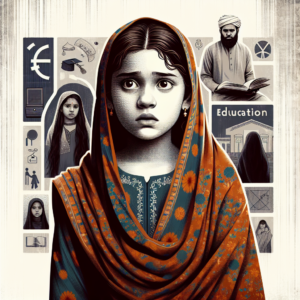The Tragic Consequences of Child Marriage: A Global Crisis
Introduction:
Child marriage is a deeply rooted social issue that has plagued humanity for centuries. Across the globe, millions of young girls are forced into marriage before they reach adulthood, often against their will. This practice not only violates their human rights but also has severe consequences, impacting their physical and mental well-being, as well as hindering their access to education and opportunities. This article aims to shed light on the tragic consequences of child marriage, discussing the global crisis it presents and its ramifications on individuals, families, and societies.
I. Understanding Child Marriage:
Child marriage refers to the marriage or union of a child (generally defined as someone under the age of 18) before they are mentally, emotionally, and physically prepared. It is more prevalent in developing countries, where poverty, traditional customs, and gender inequalities prevail. Approximately 12 million girls worldwide are married before the age of 18 each year, with 21% of girls in developing countries being married off before their 18th birthday.
II. Physical Consequences:
One of the most significant consequences of child marriage is the severe physical toll it takes on young girls. Often forced into a premature union, girls’ bodies are not fully developed, making pregnancy and childbirth dangerous. Complications during pregnancy and childbirth are the leading cause of death for girls aged 15 to 19 in developing countries. Child brides are more susceptible to complications such as obstetric fistulas, maternal mortality, and premature birth, putting both mothers and infants at risk.
III. Emotional and Psychological Impact:
The emotional and psychological consequences of child marriage cannot be overlooked. Young girls are torn away from their families, friends, and childhood, abruptly transitioning to a married life for which they are unprepared. Forced into adult roles, child brides often experience emotional distress, anxiety, depression, and are more prone to psychological disorders. The lack of support and understanding within their marriages exacerbates these issues, making it challenging to build healthy relationships with their spouses.
IV. Education Barriers:
Child marriage acts as a significant barrier to education for young girls. Once married, they are often expected to take on household responsibilities instead of continuing their education. This perpetuates cycles of poverty and limits their future opportunities. Education enables girls to gain knowledge, skills, and confidence, empowering them to contribute positively to their communities. Denying education to girls through child marriage can have far-reaching consequences for society as a whole.
V. Economic Implications:
Child marriage also has various economic implications. Girls who marry young are often forced into early motherhood and are unable to acquire valuable skills or participate in the workforce. This perpetuates cycles of poverty for families, communities, and entire nations. Conversely, delaying child marriage and allowing girls to complete their education leads to significant social and economic benefits, including lower population growth, increased income, and improved health outcomes.
VI. Social and Cultural Factors:
Child marriage is deeply rooted in social and cultural practices, making it challenging to eradicate. Traditional gender norms, lack of education, and discriminatory beliefs contribute to the persistence of this harmful practice. To effectively combat child marriage, it is crucial to address these underlying factors, promoting gender equality, empowering girls, and educating communities on the detrimental consequences of child marriage.
FAQs:
Q: Is child marriage limited to specific regions?
A: Child marriage is prevalent in several regions, including South Asia, West and Central Africa, and the Middle East. However, it is not limited to these areas and exists in various degrees worldwide.
Q: Who are the perpetrators of child marriage?
A: Perpetrators can vary depending on the cultural context. They may include family members, community members, religious leaders, or even parents who may believe they are acting in the best interest of their child.
Q: What is being done to eradicate child marriage?
A: Various organizations, governments, and activists are working tirelessly to end child marriage. They focus on raising awareness, implementing laws and policies, providing support and services to survivors, and promoting education and empowerment for young girls.
Q: How can individuals contribute to ending child marriage?
A: Individuals can contribute to ending child marriage by supporting organizations working on this issue, raising awareness, advocating for girls’ education, and challenging cultural norms that perpetuate this harmful practice.
Conclusion:
Child marriage remains a global crisis with severe consequences for millions of young girls. It is a violation of their rights and denies them the chance to reach their full potential. To address this issue, governments, communities, and individuals must work together to challenge societal norms, promote education, and empower girls. Only through collective efforts can we put an end to this tragic practice and ensure a brighter future for all children.





















